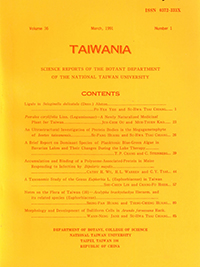Research Paper
Accumulation and Binding of a Polysome-Associated-Protein in Maize Responding to Infection by Bipolaris maydis
Cathy H. Wu, H. L. Warren, C. Y. Tsai
Published on: March 1991
Page: 44 - 56
DOI: 10.6165/tai.1991.36.44
Abstract
Previous studies indicated that a 57kDa polysome-associated-protein (p57) accumulated in cytoplasmic polysomes when W64A maize (Zea mays L.) seedlings were inoculated with Bipolaris maydis, heat shocked, or treated with the herbicide paraquat. Efforts were made to determine the binding of this protein to ribosomes, and to study whether this protein was synthesized de novo or mobilized from another cellular structure in leaf tissues responding to stress. Pulse-labeling of inoculated seedlings with 3H-leucine and treatments of seedings with the protein synthesis inhibitor, cycloheximide, indicated that p57 existed in cells before inoculation. Chloroplastic polysomes isolated from both inoculated and control leaves contained this protein. Presumably, p57 redistributed from chloroplasts to cytoplasmic polysomes and bound specifically to the 40Sribosomal subunit to inhibit translation in response to biotic and environmental stresses.
中文摘要
由以前的研究成果得知:當W64A玉米(Zea mays L.)幼苗在接種Bipolaris maydis或經熱休克或除草劑Paraquat處理過後,在細胞質內的多核醣體會累積醫種57KD多核醣體結合的蛋白質。為了要進一步了解只蛋白質是如何結合於核醣體,並研究此蛋白質是否新合成或是在逆境下,在葉部組織之細胞內不同胞器轉移的反應。已接種細菌的幼苗,先用3H-leucine標誌,再用蛋白質合成抑制劑cycloheximide處理,由結果顯示P57蛋白質在接種前已存在於細胞之內。從已接種菌種及對照組(不接菌種)的葉片所分離出綠體多核醣體部含存此蛋白質。由本研究成果推測P57是由葉綠體合成,在轉移到細胞質後重新分布,特別與40S核醣體次單元結合。在生物及環境壓迫時用以抑制蛋白質的轉譯作用。尤其是會產生毒素之品種。在過去幾年間之數量及分布情形。文中並比較以間歇性破壞溫層及去除水中磷量以達減少藍綠藻數量之效果。


